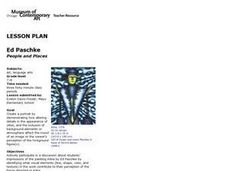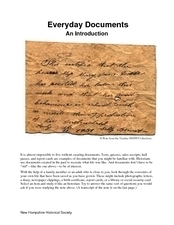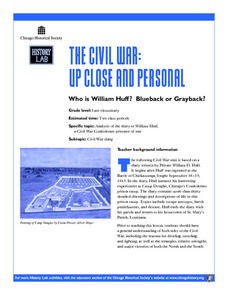Curated OER
Types of Groups
Middle schoolers are introduced to the various types of groups in a society. In groups, they create a chart showing the similarities and differences between primary, secondary, and reference groups. Using magazines, they cut out...
Curated OER
Who Were The Samurai?
Learners discover more information about samurai. They use primary and secondary sources to explain the samurai more clearly. They examine their role in society and disregard preconceptions.
Curated OER
South Korea
High schoolers use primary and secondary resources in order to investigate the culture of South Korea. They use guiding questions that progressively lead them to higher order thinking to make connections from the information to how...
Curated OER
Different Viewpoints - Loyalist or Patriot
Third graders use primary sources to study U.S. history and government. For this primary sources lesson, 3rd graders practice gathering information from "eye witness" accounts of history.
Curated OER
Danger on the Underground Railroad
Student examines the role of the Underground railroad. In this Post-Civil War lesson, 7th graders read and analyze primary sources. Students create a timeline that details the events of the stories.
Curated OER
From the Source to the Sea: The Nisqually River Watershed
Students research the conflicts over different uses of the Nisqually River resources and role play as mediators between Chief Leschi and other interested parties. They cite and interpret relevant artifacts and primary and secondary...
Curated OER
People and Places
Fifth graders investigate how the geography of the land effected the human experience of the Lewis and Clark Expedition. They research using primary and secondary sources, design a map.
Curated OER
Everyday Documents
Almost more of a lesson than a worksheet, this particular resource has learners examine different types of historical documents. There is a historical docment embedded in the worksheet that learners study, and they also bring in...
Curated OER
John and Mary Jones and the Importance of Oral History
Students examine the role of John and Mary Jones in the abolitionist movement. Using primary source documents, they discover the importance of an oral history and take notes on the Jones' role. They write a summary of the data to...
Curated OER
What It Means to Be an American Indian
Students analyze primary source documents and evaluate historical evidence to find consequences of the policies that were adopted from the 1830s to today regarding Native American Indians.
Curated OER
Endangered Animals: Hawaii
Students locate regions in Hawaii where specific endangered animals live. They describe habitats, identify reasons why the species has become endangered, consider how a healthy environment for wildlife contributes to a healthy...
Curated OER
Reporting on the 1920s
Use this roaring 1920s history lesson to have young writers research primary and secondary sources. They use their research to examine the events or famous public figures of the time period. Next, they imagine they're in the 1920s and...
Curated OER
The Civil War: Up Close and Personal
Pupils take an in depth look at different aspects of the Civil War. Using primary source documents, they discover that people who lived during the war are not so different from them. They read about the experience of a Confederate...
Curated OER
Personalities of the Renaissance
Have the class interpret historical evidence presented in primary and secondary resources. They examine sources regarding architecture, art, exploration, government, literature, religion, and technology of the era. Then they use their...
Curated OER
The Great Depression: A Study Guide Through Song
Students take a closer look at the political and social outlook during the Great Depression. In this Great Depression lesson, students analyze selected songs from the time period. Students use the provided lyric sheets and song...
Curated OER
A Sense of Community
Students brainstorm characteristics they associate with a community. In groups, they discover the role of a town square and create their own model. They also identify the various roles in keeping the community going and role play their...
Curated OER
Explore the Constitution
Students examine the U.S. Constitution. In this American history instructional activity, students explore the founders' vision of U.S. government as they participate in readers' theatre, role-playing scenarios, and constitutional...
Curated OER
Pilgrims: The First Americans
Fifth graders become familar with the pilgrims and first Thanksgiving through essays about important people of the time. In this Thanksgiving lesson, 5th graders choose an important figure from the time of the Pilgrims and write a...
Curated OER
The People of Kansas: Where Did They Come From and Why Did They Come?
Students research and discuss the reasons why early settlers emigrated to Kansas. They, in groups, analyze census district reports from the 1850's and then identify the advantages and disadvantages of using this information as research.
Curated OER
The Cherokee: The Principal People (Ani-Yunwiya), 1700 - 1838
Students read passages and research the Cherokee Tribe and write an account of a typical day as a Cherokee Native American. In this Cherokee lesson plan, students listen to Cherokee music, read Cherokee passages, fill out worksheets, and...
Curated OER
People, Places and Environments
Middle schoolers predict a future for Gary, IN and US Steel Works. They explain how their own town would change if US Steel built this large of a facility in it and discuss why or shy not their town would have been an alternative to...
Stanford University
Greensboro Sit-Ins
The Greensboro sit-in was an important event of the Civil Rights Movement, but why? Secondary learners analyze a photo from the sit-in to explain what made the event historically significant. The assessment explains what qualifies as a...
Stanford University
Buddhist Monk Protest
What makes the Buddhist Monk Protest a historically significant event? Interested historians use photographic evidence and source information to analyze and explain the importance of the event. The assessment is structured in a short...
Stanford University
Kent State
Why did a peaceful student protest end in disaster? Young historians explain the impact of the Kent State shooting. Academics analyze a photo of the Kent State shooting and explain the significance of the event by completing short answer...

























